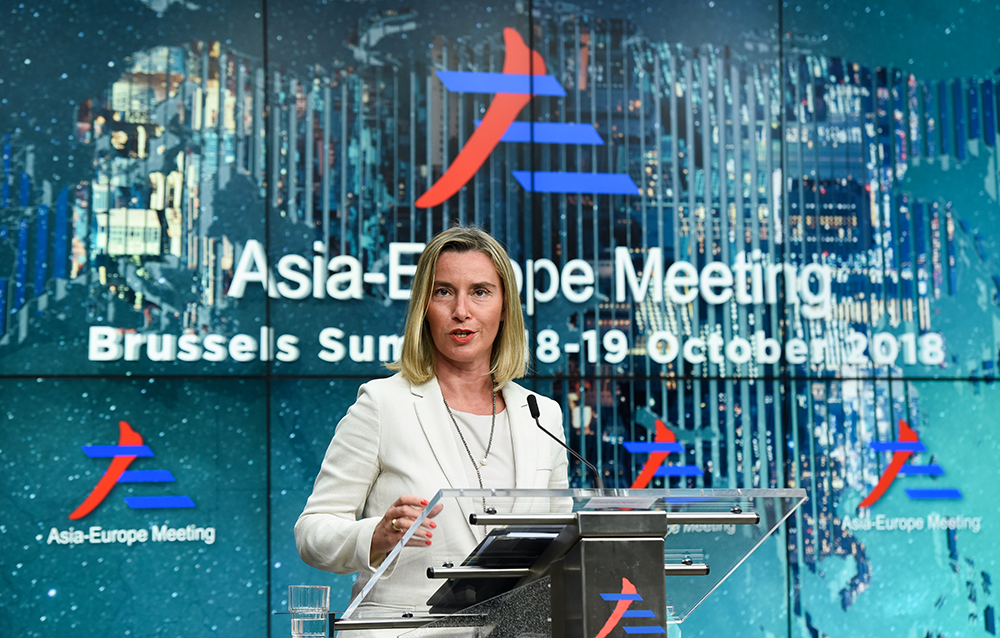
Vice President of the European Commission Federica Mogherini addresses the Asia-Europe Meeting (ASEM) on 19th October, 2018. Photo: Jennifer Jacquemart
Time to Move Up a Gear
Announced on 19th September 2018, many see the European Union’s (EU’s) strategy for connecting Europe and Asia as merely a response to China’s Belt and Road Initiative. However, High Representative of the European Union for Foreign Affairs and Security Policy and Vice President of the European Commission Federica Mogherini says that it is actually a follow-up on the 2016 EU Global Strategy. In the following article she outlines the plan in more detail, explaining that in order to derive maximum benefit for all stakeholders, Europe-Asia connectivity must be based on strong partnerships and transparent rules.
Europe and Asia have a centuries-old common history. The ties between the two continents are today reaching an unprecedented level. Asian markets account for over one third of exports from the European Union (EU). Almost half of the goods and services imported by the EU come from Asian countries. Every year, thousands of students, academics and researchers move between the EU and Asia. The cultural exchanges between our cities are vibrant. And there is more to our mutual relationship than just economic or scientific exchanges: the EU and Asian countries have a common interest in preserving a cooperative, rules-based and peaceful international system, where multilateral organisations are the natural fora for reaching common solutions. This relationship needs to rely on effective, functioning and sustainable connectivity – in other words on the physical and non-physical infrastructure through which goods, services, ideas and people can flow unhindered.
While connectivity has always been a part of the EU’s policy towards Asia, until now the EU has not used its potential in this area to the full. That is why we have proposed in September a new policy framework to step up the EU action, an EU strategy on connectivity between Europe and Asia.
Our message is clear: the EU is ready to step up its engagement with Asian partners on an agenda for connectivity, based on mutual interests and common objectives. Connectivity is in the very DNA of the EU, as a political project based on market integration. We can offer our regulatory experience, technical expertise and funding opportunities at the service of projects that help interoperability and convergence, promote fiscally and environmentally sound growth, and strengthen our connections in a way that will be beneficial for us all.
We can do this in three ways. First, the EU is ready to support new connections and networks between Europe and Asia. For example, extending our Trans-European Transport Network[1], which facilitates trade and mobility through removing technical and regulatory barriers for transport networks and modernising infrastructure to other non-EU countries would be a positive step. We will also pursue a sustainable digital agenda with Asia in order to foster universal and affordable access to digital technologies and services. We will share our experience in creating regional, liberalised energy markets with a focus on market-driven transformation towards clean energy. And we will continue to promote human exchanges and mobility through programmes such as Erasmus or the Marie Curie Action as a way to build connections, mutual understanding and the sharing of ideas.
Second, in the EU approach, connectivity can only be built in partnership. Many such partnerships exist already. The EU and China share an interest in making sure that our respective initiatives work well together, despite the differences in approach and implementation. Connectivity is not possible if systems and networks are not interoperable. As we have already been doing, the EU will continue to engage with China—in our bilateral Connectivity Platform, in the wider bilateral relationship, and in multilateral fora—to create synergies and to find commonalities. As the Joint Communication highlights, the EU will further step up its work within international organisations to set and enforce global rules and standards, which will create a level playing field and equal opportunities for all. We will work hand in hand with regional organisations and mechanisms existing in Asia, such as ASEAN, to identify and support projects.
Third, we want to work on a connectivity based on shared principles: transparency, non-discriminatory market practices, a level playing field for economic operators, protection for intellectual property rights. The best way to achieve this is not to impose anyone’s standards or rules, but to work together within international organisations on mutually acceptable ones. European companies must have a level playing field vis-à-vis their competitors and have the same access to markets abroad as others have in the EU.
Finally, we will mobilise all our levers to back projects with adequate funding, using the full potential of the European Investment Bank and the new tools for external investment policy available under the EU budget. According to the Asia Development Bank, Asia will require over euro (EUR) 1.3 trillion a year of infrastructure investment in the coming decades. The EU is ready to support Asian countries to meet such an investment challenge, leveraging public and private financing through a combination of grants, guarantees, lending and blending. Yet, investment must be fiscally viable and financially sustainable. The EU will only support projects that mobilise domestic resources, create value for local communities and are sustainable in the long term.
Together, Europe and Asia account for almost 70 per cent of the global population and over 60 per cent of the world’s GDP. There is space for making our ties stronger and more mutually beneficial. Sustainable connectivity, based on strong partnerships and transparent rules is, for the EU, European and Asian countries, the best way forward.
[1] https://ec.europa.eu/transport/themes/infrastructure_en


Recent Comments